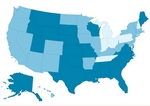business
Decline in doctor office visits could be permanent
■ Studies suggest that recent declines reflect cost-conscious patients training themselves to avoid making an appointment unless they believe it's absolutely necessary.
By Emily Berry — Posted Oct. 31, 2011
- WITH THIS STORY:
- » How deep is the dip?
- » Related content
The number of visits patients make to physicians in a given month -- a vital sign for the whole health care economy -- has been declining consistently, according to multiple tracking studies, companies and researchers.
Analysts say those numbers may not bounce back, even with health system reform. That's because a struggling economy, higher insurance deductibles, and the efforts by health plans and others to reduce utilization have altered patient patterns, perhaps permanently. Patients now often seek office visits -- or any interaction with the health system -- only when a problem can't be ignored.
"I don't think we'll see the same utilization patterns again," said Michael Thompson, a New York-based principal for PwC's Global Human Resources Division, which surveys clients on health issues. "Health care is not free anymore. That has an impact on how people are engaging the system."
John Rex, an investment analyst at JP Morgan Chase in New York, tracks patient visit volume because it affects demand -- and therefore profitability -- in the pharmaceutical, medical device and health insurance sectors. Physicians are at the center of that economic ripple effect.
A report Rex released Oct. 12, based on data from Thomson Reuters Healthcare and his own estimates, showed an 8% decline in office visits per full-time equivalent physician for September 2011 compared with a year earlier. It was the third consecutive month of declines compared with the same months in 2010, and the fourth decline in five months. Primary care was especially hard hit, Rex said.
Johnson & Johnson, like other pharmaceutical companies and medical device manufacturers, closely tracks physician visits and the volume of procedures and prescriptions, because those figures so directly drive their profitability.
In the company's Oct. 18 third-quarter earnings call, Executive Vice President and Chief Financial Officer Dominic Caruso noted "tough macroeconomic conditions" affecting the company because it sees physician office visits "declining dramatically. I think we're now down up to nine consecutive quarters of physician office visits declining." He said the conditions are "still troublesome in terms of their impact on health care utilization. I don't see them necessarily getting worse. I just see them persisting."
Murray Aitken, executive director of IMS Institute for Healthcare Informatics, a health care research firm based in Danbury, Conn., recorded an audio note saying IMS tracked an overall 4% drop in patient visits in 2011 compared with 2010. That was a continuation of a longer-term trend: Office visits had declined by 4.2% from mid-2009 to mid- 2010, he said.
The present downward trend, he said, "may be reflective of enduring effect of high unemployment levels and rising health care costs, including the out-of-pocket costs, and may include more patients losing coverage as well as others managing their health care spending more carefully."
PwC's Thompson said his organization has seen slowing health care utilization, in contrast with the past, when health care costs kept growing consistently as other parts of the economy stalled. National health spending overall grew by about 4% in both 2009 and 2010, the lowest growth rate since at least 1960, according to the Centers for Medicare & Medicaid Services Office of the Actuary.
Adjusting to change
Some doctors may not have noticed an ease in demand. "This is isn't like moving from 10 to five patients per day; it's more like 10 to 9.5. ... I would imagine that's not enough for them to perceive a huge decline in need," said Gary Pickens, PhD, chief research officer at Thomson Reuters' Center for Healthcare Analytics.
Robert Kaufmann, MD, a solo Atlanta internist, said he has not seen a drop in patient volume -- he's busier than ever, thanks to keeping an open schedule with same-day appointments. He sees about 40 patients a day, about 25% of them on Medicare.
But Dr. Kaufmann has noticed that his patients are sicker when they come to him. They often have avoided visits because they still are paying their deductibles, even if a plan covers 100% of preventive visits. And those who come in before deductibles are paid off often aren't happy.
"Sometimes they'll get mad at me and say, 'I wouldn't have had this test if I had known that,' but I say, 'Listen, I can barely keep up with my own personal insurance -- I've got a $10,000 deductible. I'll trade with you.' "
At Buffalo (N.Y.) Medical Group, a multispecialty group of 102 physicians at 25 offices, primary care visits declined by 4.3% from 2008 to 2009, then 2.2% from 2009 to 2010, CEO Dan Scully said. He attributed the drop in part to a rise in the amount of out-of-pocket costs most patients carry as enrollees in high-deductible health plans paired with health savings accounts, and to the availability of retail and urgent care clinics.
However, Scully said the practice also has moved to quality-based contracting with payers. Moreover, it has begun offering at-home care to patients with chronic diseases and directed care where appropriate to nurses and physician assistants. Because of that, the drop in visits doesn't mean a drop in income, he said.
There are expectations that health spending -- and office visits -- will rebound with more patients in 2014, when the Patient Protection and Affordable Care Act is operating in full. But although the newly covered might come to the doctor's office, Thompson said, those already covered still will have the same high levels of cost-sharing and will keep avoiding visits as long as possible.












